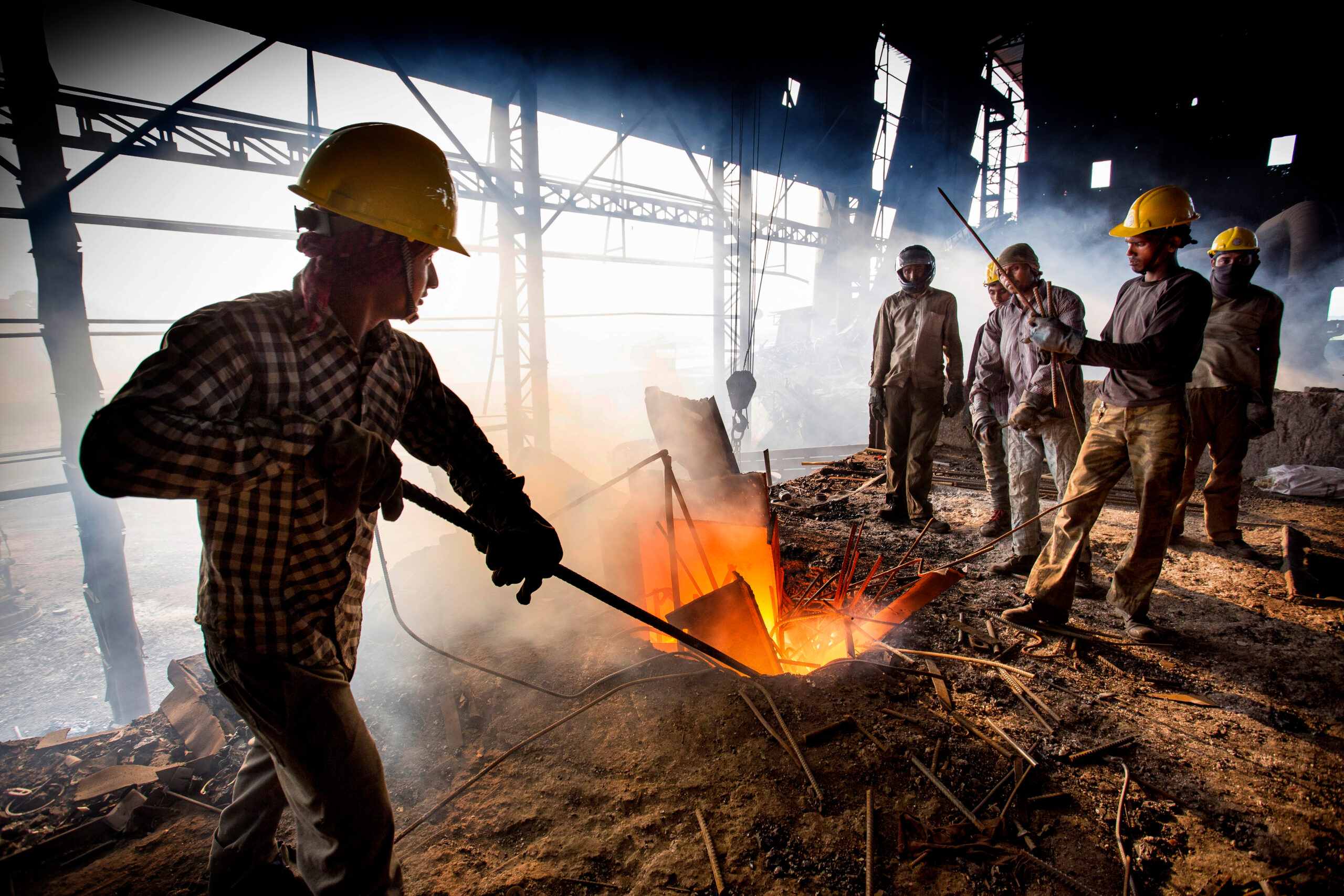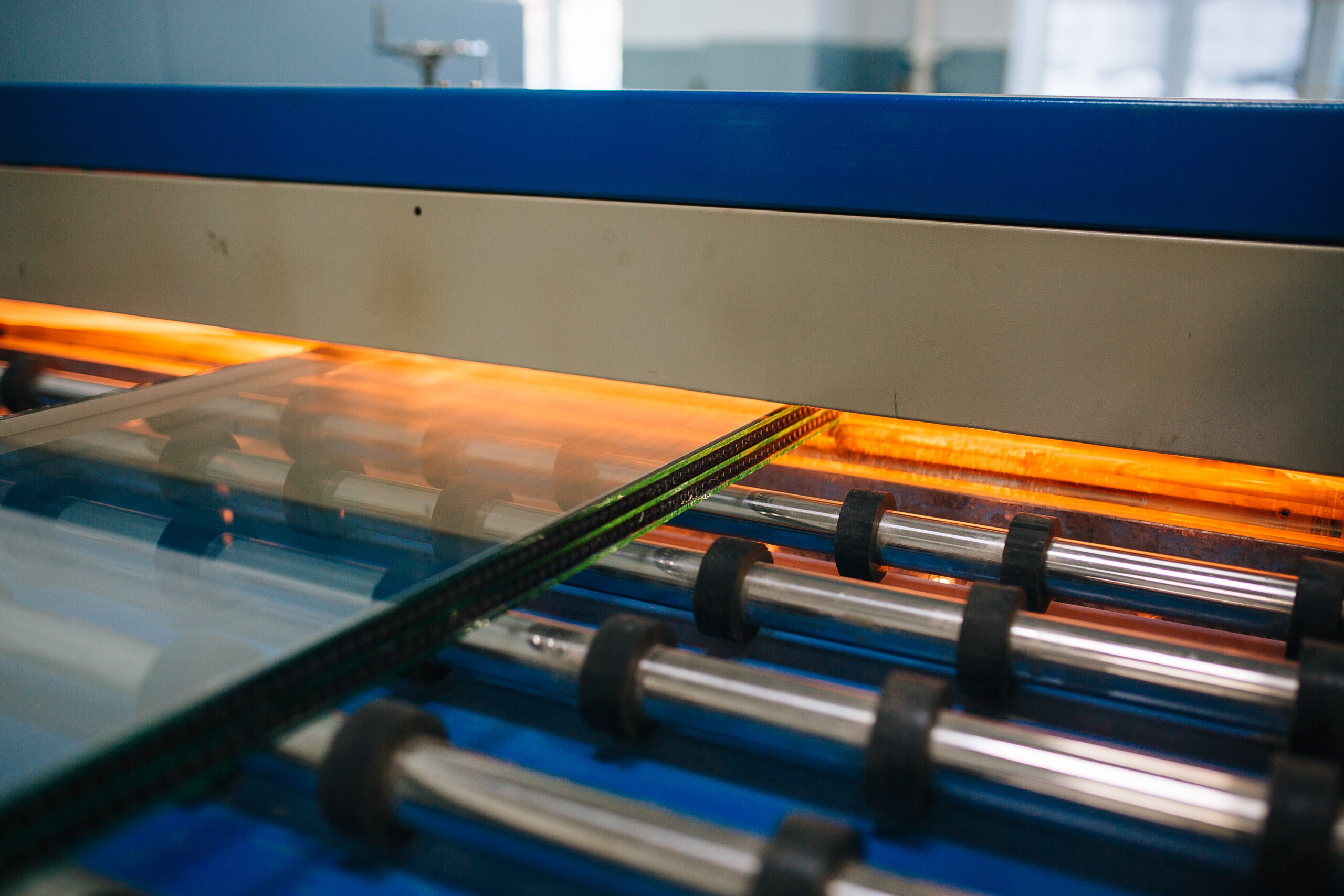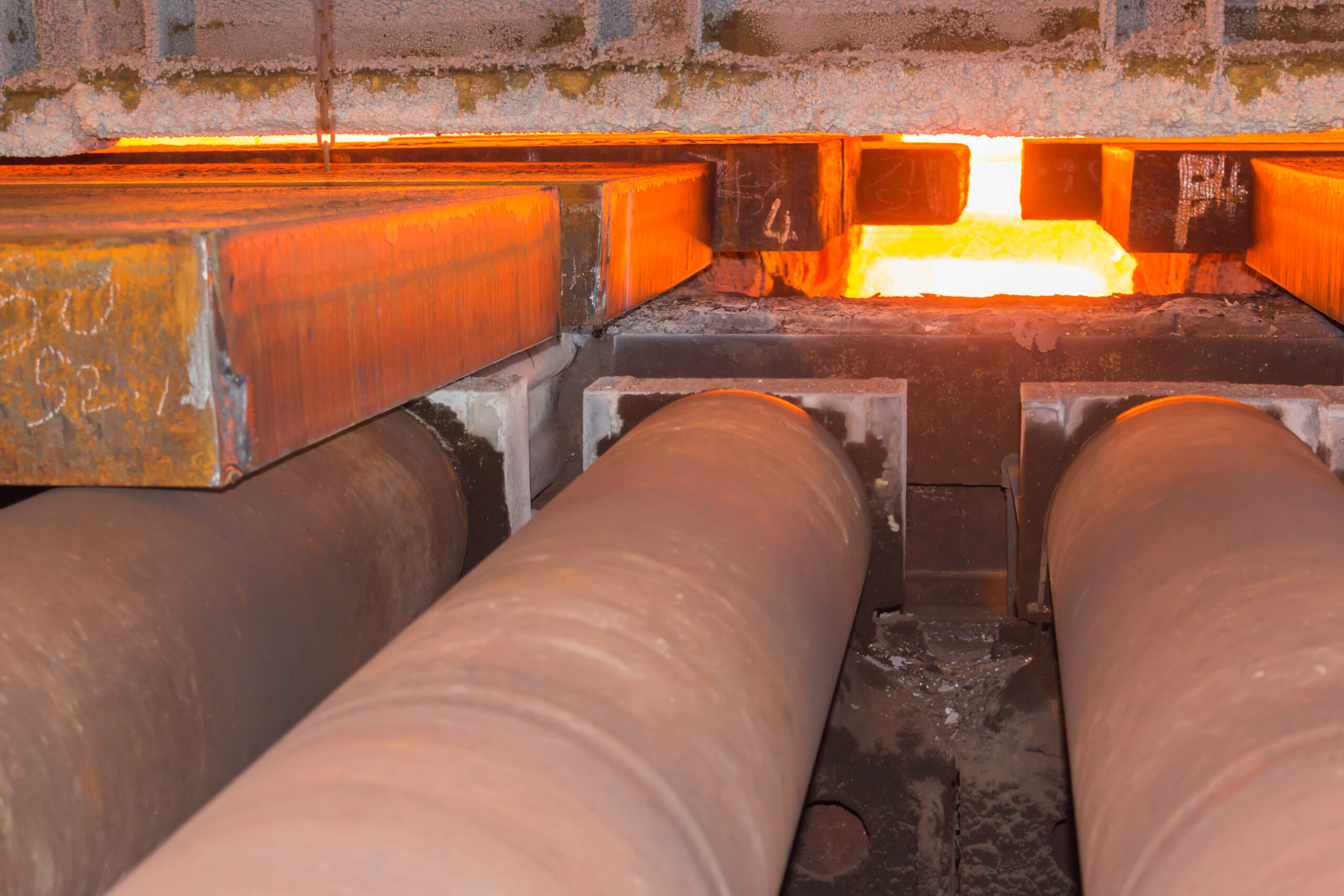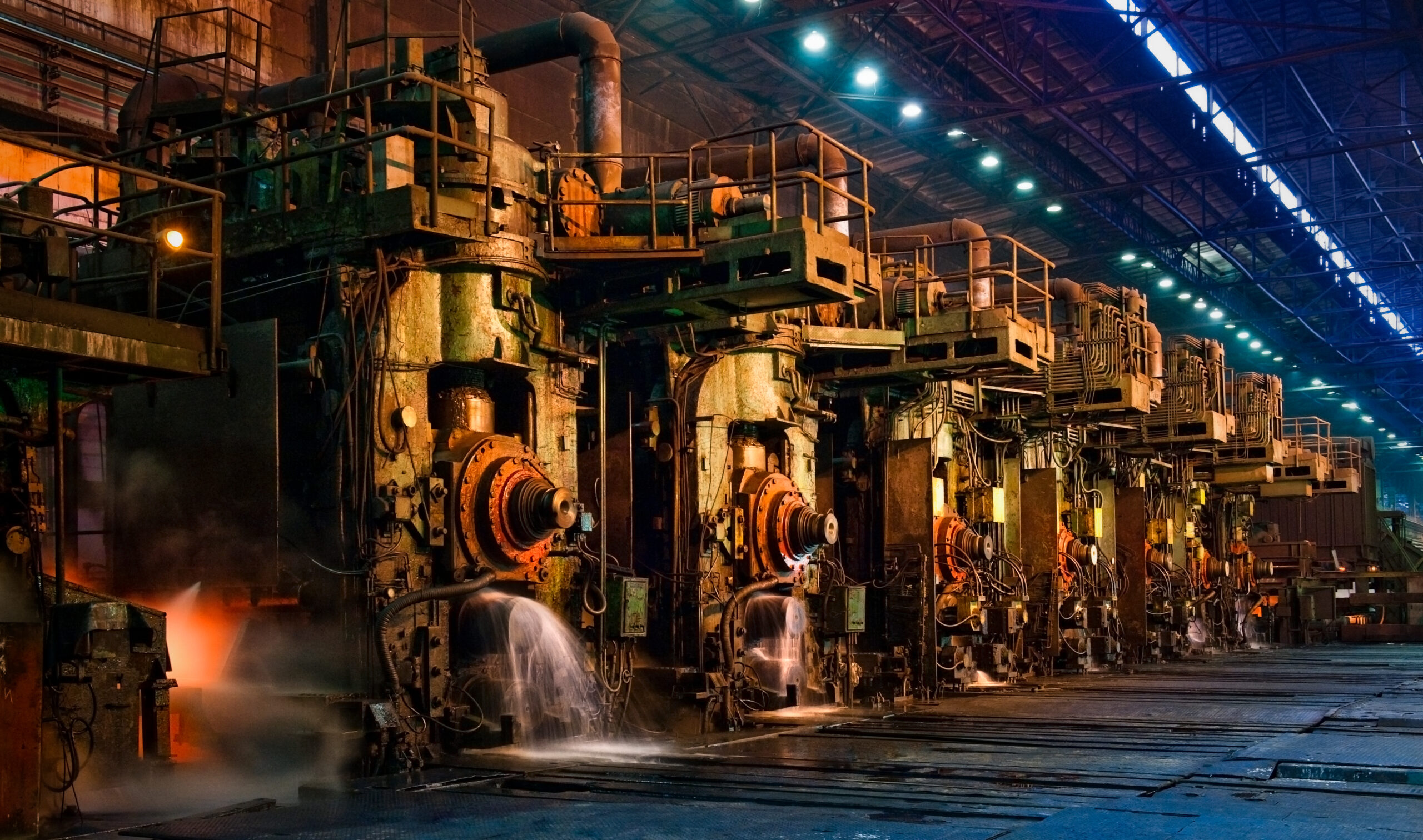Page 7 of 12
Foundry: Cast Iron and pouring of molten metal
Home Case Studies Foundry: Cast Iron and Pouring of Molten Metal Foundry: Cast Iron and Pouring of Molten Metal Handheld Portable Infrared Sensor provides accurate temperature measurement Challenges To measure temperature during the time of pouring Reduce the tip consumption costs Portable temperature measurement device for tapping and pouring process Error in measurement for non-contact IR sensor due emissivity adjustment Solution Handheld Pyrometer provides spectral range for molten metal Wide temp range 1000 to 2000°C Dual Laser for target alignment 2000 values can be transferred to PC via USBHandheld Products and Accessories Handheld Pyrometer Features Short measurement wavelength of 0.5μm Wide temperature range : 1000 to 2000°C Dual Laser spot for target alignment and LCD display Data storage up to 2000 measurement values and USB connect to PC Other Solutions for Molten Metal Melt IR System Case Study Number TP3 Challenge The increasing flexibility of production lines requires a high adaptability of sensors. Continually changing object geometries, different temperatures and very high radiation or surrounding temperatures are no rarity. In a pilger mill those rough conditions can be found, among others in the production of seemless steel pipes. The raw steel blocks, each weighing a few tons are heated up first in a round oven at a temperature of 1300 °C. After descaling of the surface, the steel block is prepunched in a hole press with a strength from a converted 2000 t. In the next sloping rolling mill the growing pipe rotates between two rollers that are positioned at an angle to each other. The punching is widened to the size of the mandrel diameter. Previous solution / Competitor product N/A Solution The sensor that was installed at this application is the HMD OKA 2038.38 G with tube OL 19. The signal of the infrared sensors controls the movement of centering device and abutment. The point of view is restricted by the tube and prevents disturbances by steam in the cooling phase. An optimum adaptation to the operating conditions is given due to the adjustable response temperature. The HMD with self-learning response temperature (Auto-Teach function) is suited to continually changing conditions. The compact sensor with a stainless steel housing can withstand surrounding temperatures of up to 75° C. The use of a cooling jacket raises this up to 200° C. Alternatively sensors with fibre optic cables are available which permit an application at ambient temperatures up to 600° C without cooling. Customer Benefits Maintenance-free High temperature stability Recognition of hot objects at big distances Self adjustment with Auto-Teach or step switch for the response temperature Product Part number OKA 2038.38 G Brand Proxitron Accessories Piros swivel stand HM2 Tube OL 19 Pilot light unit (for alignment) DAK 308 + OL 26 Different cable lengths (e.g. 15 m) Customer Testimonial compared to previous solution or competition Case Studies Other Solutions in Casting and Forging Sample case study title lorem ipsum here Short description of the problem solved, maybe include the client name. READ MORE Sample case study title lorem ipsum here Short description of the problem solved, maybe include the client name. READ MORE Sample case study title lorem ipsum here Short description of the problem solved, maybe include the client name. READ MORE View All

Tags: Foundry, Pouring Temperature
September 22, 2021
Molten tapping temperature measurement in cast iron foundry
Tapping temperature in Cast Iron Foundry. Reduction in power consumption as overheating is prevented due to frequent temp readings. High accuracy as result within +/-50C compared to thermocouple dip type. Plug and play system, commissioned with one heat. Reduction in consumable costs by 70% Home Case Studies Molten tapping temperature measurement in cast iron foundry Molten tapping temperature measurement in cast iron foundry Home Case Studies Pilger mill in tube rolling mills – hot and cold pipe detection Pilger mill in tube rolling mills – hot and cold pipe detection Tapping temperature at Cast iron foundry Reduction in power consumption as overheating is prevented due to frequent temp readings High accuracy as result within +/-50C compared to thermocouple dip type Plug and play system, commissioned with one heat Reduction in consumable costs by 70% Challenges Reduce power consumption due to overheating Reduce casting rejection rate caused by infrequent interval temperature measurement Reduce consumable cost Increase personnel safety as hazardous area to look actual process during melting. Solution Special spectral range for molten metal. Temperature range from 1000-20000C. Dual laser for easy finding of spot area / alignment Installation Ease: Distance 4 – 8 meters away from furnace | 50 – 90 ° mounting angle Products and Accessories Other Solutions for Molten Metal IR Melt System Features Quick installation: Plug and play Trigger button: operator to initiate new measurement Cable Protection: from high temperature and molten splash Dual colour change LCD Display Cooling system for 175⁰C ambient Thermal Camera 900 to 2450°C Portable for Molten Metal 900-2000°C Case Study Number TP3 Challenge The increasing flexibility of production lines requires a high adaptability of sensors. Continually changing object geometries, different temperatures and very high radiation or surrounding temperatures are no rarity. In a pilger mill those rough conditions can be found, among others in the production of seemless steel pipes. The raw steel blocks, each weighing a few tons are heated up first in a round oven at a temperature of 1300 °C. After descaling of the surface, the steel block is prepunched in a hole press with a strength from a converted 2000 t. In the next sloping rolling mill the growing pipe rotates between two rollers that are positioned at an angle to each other. The punching is widened to the size of the mandrel diameter. Previous solution / Competitor product N/A Solution The sensor that was installed at this application is the HMD OKA 2038.38 G with tube OL 19. The signal of the infrared sensors controls the movement of centering device and abutment. The point of view is restricted by the tube and prevents disturbances by steam in the cooling phase. An optimum adaptation to the operating conditions is given due to the adjustable response temperature. The HMD with self-learning response temperature (Auto-Teach function) is suited to continually changing conditions. The compact sensor with a stainless steel housing can withstand surrounding temperatures of up to 75° C. The use of a cooling jacket raises this up to 200° C. Alternatively sensors with fibre optic cables are available which permit an application at ambient temperatures up to 600° C without cooling. Customer Benefits Maintenance-free High temperature stability Recognition of hot objects at big distances Self adjustment with Auto-Teach or step switch for the response temperature Product Part number OKA 2038.38 G Brand Proxitron Accessories Piros swivel stand HM2 Tube OL 19 Pilot light unit (for alignment) DAK 308 + OL 26 Different cable lengths (e.g. 15 m) Customer Testimonial compared to previous solution or competition Case Studies Other Solutions in Casting and Forging Sample case study title lorem ipsum here Short description of the problem solved, maybe include the client name. READ MORE Sample case study title lorem ipsum here Short description of the problem solved, maybe include the client name. READ MORE Sample case study title lorem ipsum here Short description of the problem solved, maybe include the client name. READ MORE View All

Tags: Casting and Forging, Foundry, Tapping Temperature
September 21, 2021
Detection of large hollow pipe using proximity sensors
Bouncing effect in the pipe mill mechanically damages the proximity. Circulating trolley systems, cold strip lines, lifting bar conveyors, and other equipment are also used, in addition to roller conveyor systems. Inductive proximity switches were used, which provided safe operation for large sensing distance, and even in the presence of water, dust, emulsions and oils. Home Case Studies Detection of large hollow pipe using proximity sensors Detection of large hollow pipe using proximity sensors Home Case Studies Pilger mill in tube rolling mills – hot and cold pipe detection Pilger mill in tube rolling mills – hot and cold pipe detection Reliable detection of hot objects up to up to +230 °C High operating distance to preserve sensors from mechanical shocks Safe operation also with water, fog, snow, vapor or dust Adjustable response temperature Extremely high resistance to pollution Challenges Bouncing effect in the pipe mill mechanically damages the proximity Circulating trolley systems, cold strip lines, lifting bar conveyors, and other equipment are also used, in addition to roller conveyor systems Solution Inductive proximity switches were used, which provided safe operation for large sensing distance, and even in the presence of water, dust, emulsions and oils. Sn: 140 mm IP 67 Temp: -25 to +70 °C Supply voltage: 20-260 V AC/DC Cable length: 2,5,10,15,20 m Cable MOC: Silicone cable No. of wires: 3-wire Housing (Ǿ): 110x110x43 Cable conduit protection available Products and Accessories Inductive Proximity Sensors Cable Protection Conduits Case Study Number TP3 Challenge The increasing flexibility of production lines requires a high adaptability of sensors. Continually changing object geometries, different temperatures and very high radiation or surrounding temperatures are no rarity. In a pilger mill those rough conditions can be found, among others in the production of seemless steel pipes. The raw steel blocks, each weighing a few tons are heated up first in a round oven at a temperature of 1300 °C. After descaling of the surface, the steel block is prepunched in a hole press with a strength from a converted 2000 t. In the next sloping rolling mill the growing pipe rotates between two rollers that are positioned at an angle to each other. The punching is widened to the size of the mandrel diameter. Previous solution / Competitor product N/A Solution The sensor that was installed at this application is the HMD OKA 2038.38 G with tube OL 19. The signal of the infrared sensors controls the movement of centering device and abutment. The point of view is restricted by the tube and prevents disturbances by steam in the cooling phase. An optimum adaptation to the operating conditions is given due to the adjustable response temperature. The HMD with self-learning response temperature (Auto-Teach function) is suited to continually changing conditions. The compact sensor with a stainless steel housing can withstand surrounding temperatures of up to 75° C. The use of a cooling jacket raises this up to 200° C. Alternatively sensors with fibre optic cables are available which permit an application at ambient temperatures up to 600° C without cooling. Customer Benefits Maintenance-free High temperature stability Recognition of hot objects at big distances Self adjustment with Auto-Teach or step switch for the response temperature Product Part number OKA 2038.38 G Brand Proxitron Accessories Piros swivel stand HM2 Tube OL 19 Pilot light unit (for alignment) DAK 308 + OL 26 Different cable lengths (e.g. 15 m) Customer Testimonial compared to previous solution or competition Case Studies Other Solutions Sample case study title lorem ipsum here Short description of the problem solved, maybe include the client name. READ MORE Sample case study title lorem ipsum here Short description of the problem solved, maybe include the client name. READ MORE Sample case study title lorem ipsum here Short description of the problem solved, maybe include the client name. READ MORE View All

Tags: Proximity sensors, Tubes and pipes
HMD in pilger mill in tube rolling mills
Continually changing object geometries, different temperatures and very high radiation/ surrounding temperatures. The raw steel blocks, each weighing a few tons are heated up first in a round oven at a temperature of 1300°C. The signal of the infrared sensors controls the movement of centering device and abutment. The point of view is restricted by the tube and prevents disturbances by steam in the cooling phase.Optimum adaptation to operating conditions is given due to the adjustable response temperature.Self-learning response temperature (Auto-Teach function) is suited to continually changing conditions. Home Case Studies HMD in pilger mill in tube rolling mills HMD in pilger mill in tube rolling mills Home Case Studies Pilger mill in tube rolling mills – hot and cold pipe detection Pilger mill in tube rolling mills – hot and cold pipe detection Maintenance-free. High temperature stability. Recognition of hot objects at big distances. Self adjustment with Auto-Teach or step switch for the response temperature. Challenges Continually changing object geometries, different temperatures and very high radiation/ surrounding temperatures. The raw steel blocks, each weighing a few tons are heated up first in a round oven at a temperature of 1300°C. Solution The signal of the infrared sensors controls the movement of centering device and abutment. The point of view is restricted by the tube and prevents disturbances by steam in the cooling phase. Optimum adaptation to operating conditions is given due to the adjustable response temperature. Self-learning response temperature (Auto-Teach function) is suited to continually changing conditions. Products and Accessories Hot Metal Detector Case Study Number TP3 Challenge The increasing flexibility of production lines requires a high adaptability of sensors. Continually changing object geometries, different temperatures and very high radiation or surrounding temperatures are no rarity. In a pilger mill those rough conditions can be found, among others in the production of seemless steel pipes. The raw steel blocks, each weighing a few tons are heated up first in a round oven at a temperature of 1300 °C. After descaling of the surface, the steel block is prepunched in a hole press with a strength from a converted 2000 t. In the next sloping rolling mill the growing pipe rotates between two rollers that are positioned at an angle to each other. The punching is widened to the size of the mandrel diameter. Previous solution / Competitor product N/A Solution The sensor that was installed at this application is the HMD OKA 2038.38 G with tube OL 19. The signal of the infrared sensors controls the movement of centering device and abutment. The point of view is restricted by the tube and prevents disturbances by steam in the cooling phase. An optimum adaptation to the operating conditions is given due to the adjustable response temperature. The HMD with self-learning response temperature (Auto-Teach function) is suited to continually changing conditions. The compact sensor with a stainless steel housing can withstand surrounding temperatures of up to 75° C. The use of a cooling jacket raises this up to 200° C. Alternatively sensors with fibre optic cables are available which permit an application at ambient temperatures up to 600° C without cooling. Customer Benefits Maintenance-free High temperature stability Recognition of hot objects at big distances Self adjustment with Auto-Teach or step switch for the response temperature Product Part number OKA 2038.38 G Brand Proxitron Accessories Piros swivel stand HM2 Tube OL 19 Pilot light unit (for alignment) DAK 308 + OL 26 Different cable lengths (e.g. 15 m) Customer Testimonial compared to previous solution or competition Case Studies Other Solutions Sample case study title lorem ipsum here Short description of the problem solved, maybe include the client name. READ MORE Sample case study title lorem ipsum here Short description of the problem solved, maybe include the client name. READ MORE Sample case study title lorem ipsum here Short description of the problem solved, maybe include the client name. READ MORE View All

Glass Panel Position Measurement using Laser Distance Sensors
In the area of the facility where glass panels are staged, a servodriven actuator system identifies and tracks the leading edge of the glass as it moves along the facility’s conveyor line. After the conveyor apparatus picks up the glass, it is unable to compensate for the non-standard height of the pallets used to transport andstore the glass panels in a horizontal position. Home Case Studies Glass Panel Position Measurement using Laser Distance Sensors Glass Panel Position Measurement using Laser Distance Sensors Home Case Studies Pilger mill in tube rolling mills – hot and cold pipe detection Pilger mill in tube rolling mills – hot and cold pipe detection Easy installation thanks to visible laser beam Easy configuration thanks to the free software Operation in the largest temperature range (-40°C to +60°C) possible Measuring ranges up to 100 m on natural surfaces | Measuring ranges up to 500 m on reflective foil Accuracy ± 1mm | Measurements can be acquired by a PLC or PC | Maintenance-free operation Task Leading manufacturers of insulating glass units require a sensor solution that monitors and precisely adjusts glass panel positioning on a production conveyor belt, based on the exact height of non-standard pallets. These pallets are used to transport and store glass panels horizontally. Solution Dimetix Laser Distance Sensors offer several methods of communicating tocontrol systems commonly used in manufacturing and productionapplications. In the area of the facility where glass panels are staged, a servodriven actuator system identifies and tracks the leading edge of the glass as it moves along the facility’s conveyor line. After the conveyor apparatus picks up the glass, it is unable to compensate for the non-standard height of the pallets used to transport andstore the glass panels in a horizontal position. Dimetix Laser Distance Sensor measure the height of the pallet and adjust a position to stop the glass panel. After the panel is halted, the machine begins tilting it onto the pallet precisely at the point where there is no chance the glass can slide or be misplaced. It is then gently placed on the pallets next to other glass panels. Products and Accessories Laser Distance Meter Case Study Number TP3 Challenge The increasing flexibility of production lines requires a high adaptability of sensors. Continually changing object geometries, different temperatures and very high radiation or surrounding temperatures are no rarity. In a pilger mill those rough conditions can be found, among others in the production of seemless steel pipes. The raw steel blocks, each weighing a few tons are heated up first in a round oven at a temperature of 1300 °C. After descaling of the surface, the steel block is prepunched in a hole press with a strength from a converted 2000 t. In the next sloping rolling mill the growing pipe rotates between two rollers that are positioned at an angle to each other. The punching is widened to the size of the mandrel diameter. Previous solution / Competitor product N/A Solution The sensor that was installed at this application is the HMD OKA 2038.38 G with tube OL 19. The signal of the infrared sensors controls the movement of centering device and abutment. The point of view is restricted by the tube and prevents disturbances by steam in the cooling phase. An optimum adaptation to the operating conditions is given due to the adjustable response temperature. The HMD with self-learning response temperature (Auto-Teach function) is suited to continually changing conditions. The compact sensor with a stainless steel housing can withstand surrounding temperatures of up to 75° C. The use of a cooling jacket raises this up to 200° C. Alternatively sensors with fibre optic cables are available which permit an application at ambient temperatures up to 600° C without cooling. Customer Benefits Maintenance-free High temperature stability Recognition of hot objects at big distances Self adjustment with Auto-Teach or step switch for the response temperature Product Part number OKA 2038.38 G Brand Proxitron Accessories Piros swivel stand HM2 Tube OL 19 Pilot light unit (for alignment) DAK 308 + OL 26 Different cable lengths (e.g. 15 m) Customer Testimonial compared to previous solution or competition Case Studies Other Solutions Sample case study title lorem ipsum here Short description of the problem solved, maybe include the client name. READ MORE Sample case study title lorem ipsum here Short description of the problem solved, maybe include the client name. READ MORE Sample case study title lorem ipsum here Short description of the problem solved, maybe include the client name. READ MORE View All

Tags: Glass, laser distance sensor, panel, position measurement
September 16, 2021
Proximity for material handling in outdoor applications
Long distance proximity that is efficient operation in outdoor setting and resistant to dirt, dust. Insensitive to soiling and wear-free with plastic housing Home Case Studies Proximity for material handling in outdoor applications Proximity for material handling in outdoor applications Home Case Studies Pilger mill in tube rolling mills – hot and cold pipe detection Pilger mill in tube rolling mills – hot and cold pipe detection Efficient operation in outdoor setting Resistant to dirt, dust Insensitive to soiling and wear-free Plastic housing Specifications High sensing proximity for outdoor rugged applications Sn: 70 mm IP 67 Temperature range: -25 to +100 °C Supply voltage: 10-55 VDC Cable length: 2,5,10,15,20 m Cable MOC: Silicone cable No. of wires: 2-wire, 3-wire Housing (Ǿ): 80x80x40 Cable conduit protection available (Pg X) Products and Accessories Large sensing distance proximity Case Study Number TP3 Challenge The increasing flexibility of production lines requires a high adaptability of sensors. Continually changing object geometries, different temperatures and very high radiation or surrounding temperatures are no rarity. In a pilger mill those rough conditions can be found, among others in the production of seemless steel pipes. The raw steel blocks, each weighing a few tons are heated up first in a round oven at a temperature of 1300 °C. After descaling of the surface, the steel block is prepunched in a hole press with a strength from a converted 2000 t. In the next sloping rolling mill the growing pipe rotates between two rollers that are positioned at an angle to each other. The punching is widened to the size of the mandrel diameter. Previous solution / Competitor product N/A Solution The sensor that was installed at this application is the HMD OKA 2038.38 G with tube OL 19. The signal of the infrared sensors controls the movement of centering device and abutment. The point of view is restricted by the tube and prevents disturbances by steam in the cooling phase. An optimum adaptation to the operating conditions is given due to the adjustable response temperature. The HMD with self-learning response temperature (Auto-Teach function) is suited to continually changing conditions. The compact sensor with a stainless steel housing can withstand surrounding temperatures of up to 75° C. The use of a cooling jacket raises this up to 200° C. Alternatively sensors with fibre optic cables are available which permit an application at ambient temperatures up to 600° C without cooling. Customer Benefits Maintenance-free High temperature stability Recognition of hot objects at big distances Self adjustment with Auto-Teach or step switch for the response temperature Product Part number OKA 2038.38 G Brand Proxitron Accessories Piros swivel stand HM2 Tube OL 19 Pilot light unit (for alignment) DAK 308 + OL 26 Different cable lengths (e.g. 15 m) Customer Testimonial compared to previous solution or competition Case Studies Other Solutions Sample case study title lorem ipsum here Short description of the problem solved, maybe include the client name. READ MORE Sample case study title lorem ipsum here Short description of the problem solved, maybe include the client name. READ MORE Sample case study title lorem ipsum here Short description of the problem solved, maybe include the client name. READ MORE View All

Tags: long distance, material handling, mining, outdoor, Proximity
Wind positioning with relay outputs
Speed monitors enable safe monitoring in accordance with SIL3/PLe. These safety relays have 2 synchronous relays and 4×2 control outputs. The speed monitors can work with both digital and SinCos signal Home Case Studies Wind positioning with relay outputs Wind positioning with relay outputs Home Case Studies Pilger mill in tube rolling mills – hot and cold pipe detection Pilger mill in tube rolling mills – hot and cold pipe detection Speed monitors enable safe monitoring in accordance with SIL3/PLe. These safety relays have 2 synchronous relays and 4×2 control outputs. The speed monitors can work with both digital and SinCos signal Maximise productivity and safety: Precise wind-sensors Challenges Precise control for machines running at optimum productivity. Strike a balance between productivity and safety. Solution Process indicators equipped with two relay outputs can be used with an anemometer as a wind warning device. With fully calibrated wind sensors (anemometer) to strike balance between maximize machine availability and equipment safety. Heater option available for cold climate conditions. Safety relay monitor can be easily added on. Multiple solutions for wind monitoring are possible. Simple monitoring of the wind speed Basic wind speed monitoring can be achieved by connecting a process Indicator with two 16 bit Analog Inputs to an anemometer with an analog output. Alternatively a digital indicator is required to work with an anemometer with frequency output. Safe operation of the wind speed Better operating safety can be achieved by the parallel operation of two analog or two digital indicators. If a cable break occurs, the second signal path remains intact and continues to reliably monitor the wind speed. Maximum security of monitoring wind speed. even greater security of the monitoring is possible by connecting a digital and analog anemometer + process indicator.With an analog anemometer connected to a digital indicator and a digital anemometer connected to a digital indicator, a wide range of measurement approaches are possible resulting in limited error margins. Pedestal for vertical mounting and pendulum for wall mounting. Products and Accessories Anemometer Process Display Case Study Number TP3 Challenge The increasing flexibility of production lines requires a high adaptability of sensors. Continually changing object geometries, different temperatures and very high radiation or surrounding temperatures are no rarity. In a pilger mill those rough conditions can be found, among others in the production of seemless steel pipes. The raw steel blocks, each weighing a few tons are heated up first in a round oven at a temperature of 1300 °C. After descaling of the surface, the steel block is prepunched in a hole press with a strength from a converted 2000 t. In the next sloping rolling mill the growing pipe rotates between two rollers that are positioned at an angle to each other. The punching is widened to the size of the mandrel diameter. Previous solution / Competitor product N/A Solution The sensor that was installed at this application is the HMD OKA 2038.38 G with tube OL 19. The signal of the infrared sensors controls the movement of centering device and abutment. The point of view is restricted by the tube and prevents disturbances by steam in the cooling phase. An optimum adaptation to the operating conditions is given due to the adjustable response temperature. The HMD with self-learning response temperature (Auto-Teach function) is suited to continually changing conditions. The compact sensor with a stainless steel housing can withstand surrounding temperatures of up to 75° C. The use of a cooling jacket raises this up to 200° C. Alternatively sensors with fibre optic cables are available which permit an application at ambient temperatures up to 600° C without cooling. Customer Benefits Maintenance-free High temperature stability Recognition of hot objects at big distances Self adjustment with Auto-Teach or step switch for the response temperature Product Part number OKA 2038.38 G Brand Proxitron Accessories Piros swivel stand HM2 Tube OL 19 Pilot light unit (for alignment) DAK 308 + OL 26 Different cable lengths (e.g. 15 m) Customer Testimonial compared to previous solution or competition Case Studies Other Solutions Sample case study title lorem ipsum here Short description of the problem solved, maybe include the client name. READ MORE Sample case study title lorem ipsum here Short description of the problem solved, maybe include the client name. READ MORE Sample case study title lorem ipsum here Short description of the problem solved, maybe include the client name. READ MORE View All

Tags: Anemometer, mining, Wind positioning
Walking Beam Position using Rope Length Transmitter
Heavy duty rope length transmitter was designed for these harsh environment conditions:- higher force rope and thicker rope of 2mm with PA coating instead of standard 0.8mm / 1.35mm. Rope can be easily changed by the customer themselves. Open designed with grooves allowed dust not getting collected inside the drum. Home Case Studies Walking Beam Position using Rope Length Transmitters Walking Beam Position using Rope Length Transmitters Home Case Studies Pilger mill in tube rolling mills – hot and cold pipe detection Pilger mill in tube rolling mills – hot and cold pipe detection Detection of walking beam position Robust mechanism Double side pulley Efficient in harsh environment Challenges Proximity cables are going through the drag chain, which were frequently getting damaged leading to production downtime No provision to install any linear sensor inside the cylinder Solution Rope length transmitter externally installed to walking beam furnace Double side pulley used so the rope can rotate from 0 to 180 degree Magnetic encoder, output: 4-20mA Products and Accessories Heavy duty draw wire Double Guide Pulley Case Study Number TP3 Challenge The increasing flexibility of production lines requires a high adaptability of sensors. Continually changing object geometries, different temperatures and very high radiation or surrounding temperatures are no rarity. In a pilger mill those rough conditions can be found, among others in the production of seemless steel pipes. The raw steel blocks, each weighing a few tons are heated up first in a round oven at a temperature of 1300 °C. After descaling of the surface, the steel block is prepunched in a hole press with a strength from a converted 2000 t. In the next sloping rolling mill the growing pipe rotates between two rollers that are positioned at an angle to each other. The punching is widened to the size of the mandrel diameter. Previous solution / Competitor product N/A Solution The sensor that was installed at this application is the HMD OKA 2038.38 G with tube OL 19. The signal of the infrared sensors controls the movement of centering device and abutment. The point of view is restricted by the tube and prevents disturbances by steam in the cooling phase. An optimum adaptation to the operating conditions is given due to the adjustable response temperature. The HMD with self-learning response temperature (Auto-Teach function) is suited to continually changing conditions. The compact sensor with a stainless steel housing can withstand surrounding temperatures of up to 75° C. The use of a cooling jacket raises this up to 200° C. Alternatively sensors with fibre optic cables are available which permit an application at ambient temperatures up to 600° C without cooling. Customer Benefits Maintenance-free High temperature stability Recognition of hot objects at big distances Self adjustment with Auto-Teach or step switch for the response temperature Product Part number OKA 2038.38 G Brand Proxitron Accessories Piros swivel stand HM2 Tube OL 19 Pilot light unit (for alignment) DAK 308 + OL 26 Different cable lengths (e.g. 15 m) Customer Testimonial compared to previous solution or competition Case Studies Other Solutions Sample case study title lorem ipsum here Short description of the problem solved, maybe include the client name. READ MORE Sample case study title lorem ipsum here Short description of the problem solved, maybe include the client name. READ MORE Sample case study title lorem ipsum here Short description of the problem solved, maybe include the client name. READ MORE View All

Tags: Hot strip mill, roll change detection, rope length transmitter
September 15, 2021
Slab Pusher Position Feedback
Rope got damaged and blocked the inlet nozzle. The plastic cover melted leading to failure of spring cartridge. The dust particle entered inside the housing. Heavy duty rope length transmitter was designed for these harsh environment conditions:-higher force rope thicker rope of 2mm with PA coating instead of standard 0.8mm / 1.35mm. Home Case Studies Slab Pusher Position Feedback Slab Pusher Position Feedback Home Case Studies Pilger mill in tube rolling mills – hot and cold pipe detection Pilger mill in tube rolling mills – hot and cold pipe detection Heavy Duty rope length transmitter for heavy duty environment Higher force Thicker rope (2mm) with PA coating Easy cleaning as it is open design Simple and robust mechanism Challenges Rope got damaged and blocked the inlet nozzle. The plastic cover melted leading to failure of spring cartridge The dust particle entered inside the housing. Solution Heavy duty rope length transmitter was designed for these harsh environment conditions:- Higher force rope Thicker rope of 2mm with PA coating instead of standard 0.8mm / 1.35mm Rope can be easily changed by the customer themselves Open designed with grooves allowed dust not getting collected inside the drum Products and Accessories Heavy duty Rope Length Transmitter Case Studies Other Solutions in Hot Strip Mill Sample case study title lorem ipsum here Short description of the problem solved, maybe include the client name. READ MORE Sample case study title lorem ipsum here Short description of the problem solved, maybe include the client name. READ MORE Sample case study title lorem ipsum here Short description of the problem solved, maybe include the client name. READ MORE View All

Tags: Hot strip mill, roll change detection, rope length transmitter
Roll change with Rope Length Transmitters
Heavy duty wire rope length transmitter was installed which solved the problems by applying higher force, consisting of thicker rope, simple and robust mechanism. Home Case Studies Roll change with Rope Length Transmitters Roll change with Rope Length Transmitters Home Case Studies Pilger mill in tube rolling mills – hot and cold pipe detection Pilger mill in tube rolling mills – hot and cold pipe detection Uninterrupted roll change for maximum machine availability and uptime Slim design option available for space constraint installation 4-20mA output signal Other electrical options like SSI / Profibus available on request Challenges Reduce the roll change time to improve productivity yield. Solution Heavy duty wire rope length transmitter was installed which solved the problems by applying higher force, consisting of thicker rope, simple and robust mechanism.It has easy cleaning, and rope can be easily changed by the customer.It has open housing with grooves in the drum. Products and Accessories Draw wire/ Rope Length Transmitter Wire Hooks for fastening Ball joint Guide Pulley Double Guide Pulley Case Study Number TP3 Challenge The increasing flexibility of production lines requires a high adaptability of sensors. Continually changing object geometries, different temperatures and very high radiation or surrounding temperatures are no rarity. In a pilger mill those rough conditions can be found, among others in the production of seemless steel pipes. The raw steel blocks, each weighing a few tons are heated up first in a round oven at a temperature of 1300 °C. After descaling of the surface, the steel block is prepunched in a hole press with a strength from a converted 2000 t. In the next sloping rolling mill the growing pipe rotates between two rollers that are positioned at an angle to each other. The punching is widened to the size of the mandrel diameter. Previous solution / Competitor product N/A Solution The sensor that was installed at this application is the HMD OKA 2038.38 G with tube OL 19. The signal of the infrared sensors controls the movement of centering device and abutment. The point of view is restricted by the tube and prevents disturbances by steam in the cooling phase. An optimum adaptation to the operating conditions is given due to the adjustable response temperature. The HMD with self-learning response temperature (Auto-Teach function) is suited to continually changing conditions. The compact sensor with a stainless steel housing can withstand surrounding temperatures of up to 75° C. The use of a cooling jacket raises this up to 200° C. Alternatively sensors with fibre optic cables are available which permit an application at ambient temperatures up to 600° C without cooling. Customer Benefits Maintenance-free High temperature stability Recognition of hot objects at big distances Self adjustment with Auto-Teach or step switch for the response temperature Product Part number OKA 2038.38 G Brand Proxitron Accessories Piros swivel stand HM2 Tube OL 19 Pilot light unit (for alignment) DAK 308 + OL 26 Different cable lengths (e.g. 15 m) Customer Testimonial compared to previous solution or competition Case Studies Other Solutions in Hot Rolling Mills Sample case study title lorem ipsum here Short description of the problem solved, maybe include the client name. READ MORE Sample case study title lorem ipsum here Short description of the problem solved, maybe include the client name. READ MORE Sample case study title lorem ipsum here Short description of the problem solved, maybe include the client name. READ MORE View All

Tags: Hot strip mill, roll change detection, rope length transmitter
Page 7 of 12
